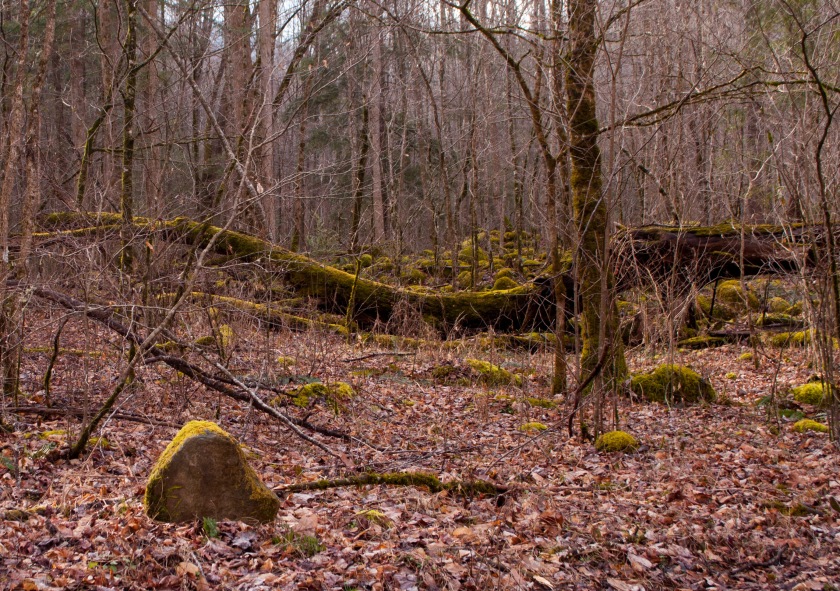Thanks to my busted up lungs, planning a trip now has an additional step: Making sure I have enough oxygen tanks to get me through whatever amount of time I’ll be gone. So when my parents surprised me with a spur-of-the-moment weekend getaway to the Smokies in January my first thought was, “Oh, crap! Do I have enough oxygen?” followed closely by, “Oh thank God, I need to get OUT!”
The trip was a “Congratulations! You took longer to finish college than Tommy Boy!” gift for FINALLY finishing my bachelor’s degree. It only took eight years and four months to finish — more than double the time it should have taken. But stopping to work, or taking an internship (or two) or just cutting back to save money stretches out that time frame just a bit. So with a carefully budgeted oxygen supply, we loaded up and set off for a much-needed three-day weekend.
My oxygen method of choice is using small, portable oxygen cylinders, also known as “E-tanks.” They are about 18 inches long, 5 inches in diameter and weigh a few pounds. I named him Gus.
Don’t judge. When you can’t leave your house without something, it deserves a name. (My iPhone is Helga. She’s a buxom Scandianavian with a ‘tude.)
Gus came with his own plain, black tote bag he straps into and gives him room to breathe – because you don’t want a leaky tank creating an oxygen pocket in an air-tight space. That could mean a BIG explosion. Usually, I’ll take that ugly black bag, strap in a tank and throw in my wallet and wear that crossbody while I’m running around. But for this trip, I decided to upgrade my oxygen transport method. Instead, I got a mint green version of this backpack from Target, big enough to hold my tank, wallet, camera – and even a pocket for my lipstick! — and hauled that around all weekend.

A short walk from a nearby parking area will get you to this cascade, but it also attaches to trails that continue to Laurel Falls.
Cascade Falls
Fortunately, we didn’t have to plan too many activities around my breathing, most of what we did involved little walking. We did attempt a “hike” — it was less than a mile, but it was long enough for me. A short trail led back to Cascade Falls, where I nearly got in a fight with rude people who kept walking into my pictures. (Seriously, people. If you see someone with a camera up to her face, maybe you shouldn’t walk right in front of her — especially if she’s carrying a metal can on her back. I’d say if that hits your face, you’ll feel it.) For the short trail back to Cascade Falls, I’d rate it three oxygen tanks because its easy getting back, but tricky getting out back up the hill.

Until the park service acquired the land in the early 1900s, this land was owned by farmers. Some cabins still stand and are maintained by the Park Service, but many of them were abandoned and removed.
Greenbrier
Hailed as one of the secret spots of the Great Smoky Mountain National Park, Greenbrier is an area of the park somewhat off the beaten path. It’s proximity to hiking make it a great area if you’re wanting to hit some trails and it also has a river that allows tubing and fishing. Of course, I didn’t try any hikes and getting in a tube in January didn’t seem like a great idea, so I can’t personally vouch for any of these activities. But I can tell you that the drive getting back to the Greenbrier area of the park was exquisite. In spring, you can see a plethora of wildflowers, but in winter the color palate is a little more basic. The only visible leaves were reduced to a dead, brown crunch under our feet and the only color to break it up the bright green moss covering rocks and trees and bits of fern peeking out from the leaves. I imagine the much-touted wildflowers in this part of the park are something to behold; this is definitely a place I want to return to in the spring.



Your writing was hysterical and fun. SO SO proud of you for showing Sjogren’s who’s boss!
Hahaha thanks, @karlikathkeen! I’ve been enjoying catching up on your blog the last couple of days, too. 🙂